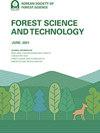Optimum plant density and harvest age for maximizing productivity and minimizing competition in a Calliandra short-rotation-coppice plantation in West Java, Indonesia
IF 2.2
Q2 FORESTRY
引用次数: 0
Abstract
Abstract To produce large volumes of biomass for implementing its green energy policy, the Government of Indonesia has issued a short rotation energy plantation program for a number of tree species including Calliandra calothyrsus (Meissn.). Optimum density and prompt harvesting are needed to maximise productivity, but information regarding both factors is insufficient. This study aimed to investigate the optimum growth spacing and ideal felling age to produce the largest volumes of biomass both economically and sustainably. Experiments were arranged on one hectare of land, which was divided into four plots with different plant spacing treatments (1 × 1.5 m; 1.5 × 1.5 m; 2 × 1.5 m; and 2 × 2 m). Growth and yield observations were carried out on plants aged 12, 18, and 24 months in each plot, with 30 sample trees left for growth observations and ten sample trees cut at each of the three ages after planting. This resulted in a total of 240 samples from the 2,710 trees planted. Trees were felled at 50 cm from the soil surface, and the resulting stools were left to regrow. A year after felling, resulting coppices, were observed and cut. Growth, productivity and calorific value were studied for both ‘primary’ and ‘coppiced’ wood. Study results demonstrate that competition between plants strongly determines the growth and productivity of ‘primary’ wood. The plot with the densest plant spacing had the lowest nutrient content for almost all soil nutrients. Higher plant density showed higher competition index values, and resulted in fewer and smaller diameter stems emerging from stools, and lower biomass productivity. Competition index values, which increased with plant age, can be used as an indicator for determining harvest timing. Productivity increased by up to 15% following development as a coppice plantation. Optimum wood productivity and greatest economy came from parent stands with plant spacing of 2 × 2 m, harvested at 18 months old and coppiced. This treatment yielded an average biomass/tree of primary wood 7.2 kg and coppice wood 8.22 kg, respectively, with lignin content of approximately 22%, and calorific value of around 18,807 kJ. These values match biomass energy requirements for feedstock for electricity generation. Harvesting at 24 months showed no significant increases in productivity, lignin content, or calorific value.在印度尼西亚西爪哇的一个短轮作卡莲德拉灌木林中,实现生产力最大化和竞争最小化的最佳植物密度和采收年龄
为了生产大量生物质以实施其绿色能源政策,印度尼西亚政府发布了包括Calliandra calothyrsus (Meissn.)在内的一些树种的短期轮作能源种植计划。为了最大限度地提高生产力,需要最佳密度和及时收获,但关于这两个因素的信息不足。本研究旨在探讨以经济和可持续的方式生产最大生物量的最佳生长间距和理想砍伐年龄。试验安排在1公顷土地上,分为4个样地,采用不同的株距处理(1 × 1.5 m;1.5 × 1.5 m;2 × 1.5 m;(2 × 2 m)。在每个样地对12、18和24月龄的植株进行生长和产量观察,在种植后的3个月龄各留下30棵样本树进行生长观察,并砍伐10棵样本树。这导致从种植的2,710棵树中总共获得240个样本。树木在离土壤表面50厘米处被砍伐,留下的粪便让其重新生长。采伐一年后,观察采伐后的灌木林。研究了“原始”和“复制”木材的生长、生产力和热值。研究结果表明,植物之间的竞争在很大程度上决定了“原始”木材的生长和生产力。株距最密的样地几乎所有土壤养分含量最低。植株密度越大,竞争指数越高,出茎量越少,茎径越小,生物量生产力越低。竞争指数值随株龄增加,可作为确定采收时机的指标。发展为灌木林后,生产力提高了15%。最优木材生产力和最大经济效益来自株距为2 × 2 m的亲本林分,在18个月龄采伐并套种。该处理产生的平均生物量/棵原材7.2 kg和灌木林8.22 kg,木质素含量约为22%,热值约为18,807 kJ。这些值与发电原料的生物质能源需求相匹配。收获24个月后,产量、木质素含量或热值没有显著增加。
本文章由计算机程序翻译,如有差异,请以英文原文为准。
求助全文
约1分钟内获得全文
求助全文

 求助内容:
求助内容: 应助结果提醒方式:
应助结果提醒方式:


